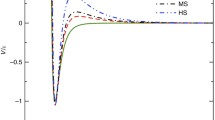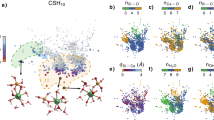Abstract
A model for the structure of calcium silicate hydrate (C−S−H) at the nanometer level (hereafter referred to as “nanometer structure”) is described, along with its possible contribution to the understanding of the mechanisms of drying shrinkage and creep in cement paste. The model was developed in two stages and describes C−S−H gel as an aggregation of precipitated, colloidal-sized particles. It was developed in an attempt to account for a number of physical characteristics of C−S−H in mature pastes, including density, surface area, fractal character, pore structure and size of individual particles. In this article the model is extended to include an hypothesis for the mechanisms of viscous deformation under load and/or during drying. As with the original model, the extension proposed here is intended to explain as much apparently unrelated data as possible. Aging (the part unrelated to the increasing amount of hydration products with time) is a process of increasing the number of bonds between globules of C−S−H, causing the C−S−H to become stiffer, stronger, and denser. We propose that deformation is the result of the globules moving under stress or drying, but the mechanism or type of rearrangement of the C−S−H particles [globules] depends on age and on whether or not the sample is dried or loaded or both.
Résumé
Est ici décrit un modèle de structure d'hydrate de silicate de calcium au niveau du nanomètre (ci-après désigné sous le nom de structure nanomètre), et sa contribution possible à la compréhension des mécanismes du retrait dû au séchage, et du fluage de la pâte de ciment. Le modèle a été développé en deux étapes et décrit le gel de C−S−H comme un agrégat des particules précipitées et de taille colloïdale. Il a été développé afin d'essayer d'expliquer un certain nombre de caractéristiques physiques du C−S−H dans les pâtes matures, incluant la densité, la surface, le caractère fractal, la structure des pores et la taille des particules individuelles. Dans cet article, le modèle est élargi pour inclure une hypothèse sur les mécanismes de la déformation visqueuse sous charge et/ou pendant le séchage. Comme avec le modèle original, l'extension proposée ici ambitionne de donner une explication à autant de données non reliées que possible. Le vieillissement (la partie non liée à la quantité croissante de produits d'hydratation dans le temps) est un processus d'augmentation du nombre de liaisons entre les globules de C−S−H, permettant au C−S−H de devenir plus raide, plus fort, et plus dense. Nous suggérons que la déformation soit le résultat du déplacement des globules sous la contrainte ou le séchage, mais le mécanisme ou le type de remise en ordre des particules de C−S−H [globules] dépend de l'âge et du fait que l'échantillon soit séché ou compressé ou bien les deux à la fois.
Similar content being viewed by others
References
Powers, T.C., ‘Physical properties of cement paste’, in Fourth International Symposium on the Chemistry of Cement, Washington, D.C., National Bureau of Standards (1960) 577–609.
Powers, T.C. and Brownyard, T.L., ‘Studies of the physical properties of hardened Portland cement paste’,PCA Bulletin 22 (1948).
Kantro, D.L., Brunauer, S. and Weise, C.H., ‘Development of surface in the hydration of calcium silicates’, in ‘Advances in Chemistry Series’ (R.F. Gould, Editor, American Chemical Society, Washington, D.C., 1961) 199–219.
Brunauer, S., ‘Tobermorite gel—the heart of concrete’,Am. Sci. 50(1) (1962) 210–29.
Taylor, H.F.W., ‘Hydrated calcium silicates. Part I. Compound formation at ordinary temperatures’,J. Chem. Soc. (1950) 3682–90.
Feldman, R.F. and Sereda, P.J., ‘A new model of hydrated cement and its practical implications’,Eng. J. Can. 53 (1970) 53–59.
Wittmann, F.H., ‘Trends in research on creep and shrinkage of concrete. in cement production and use’ (J. Skalny, New Hampshire, Engineering Foundation-New York, 1979) 143–61.
Jennings, H.M. and Tennis, P.D., Model for the Developing Microstructure in Portland Cement Pastes.J. Am. Ceram. Soc. 77(12) (1994) 3161–72.
Tennis, P.D. and Jennings, H.M., ‘A model for two types of calcium silicate hydrate in the microstructure of Portland cement pastes’,Cem. Concr. Res. 30(6) (2000) 855–63.
Jennings, H.M., ‘A model for the microstructure of calcium silicate hydrate in cement paste’,Cem. Concr. Res. 30 (2000) 101–16.
Jennings, H.M., ‘Reply to the discussion of the paper “A model for the microstructure of calcium silicate hydrate in cement paste” by I. Odler’,Cem. Concr. Res. 30(8) (2000) 1339–41.
Chen, J.J., Thomas, J.J., Taylor, H.F.W. and Jennings, H.M., ‘Solubility and structure of calcium silicate hydrate’, submitted toCement and Concrete Research (2003).
Wittmann, F., ‘Einfluss des Feuchtigkeitsgehaltes auf das Kriechen des Zementsteines’,Rheol. Acta 9 (1970) 282–287 [in German].
Thomas, J.J. and Jennings, H.M., ‘Effect of heat treatment on the pore structure and drying shrinkage behavior of hydrated cement paste’,J. Am. Ceram. Soc. 85(9) (2002) 2293–98.
Thomas, J.J. and Jennings, H.M., ‘A colloidal interpretation of chemical aging of the C−S−H and its effects on the properties of cement paste’,Cem. Concr. Res. (in press).
Feldman, R.F. and Sereda, P.J., ‘A new model of hydrated cement and its practical implications’,Eng. J. Can. 53 (1970) 53–59.
Feldman, R.F., ‘The flow of helium into the interlayer spaces of hydrated Portland cement paste’,Cem. Concr. Res. 1 (1971) 285–300.
Brunauer, S., ‘Tobermorite gel—the heart of concrete’,Am. Sci. 50(1) (1962) 210–29.
Kantro, D.L., Brunauer, S. and Weise, C.H., ‘Development of surface in the hydration of calcium silicates. II: Extension of investigations to earlier and later stages of hydration’,J. Phys. Chem. 66 (1962) 1804–09.
Brunauer, S., ‘A discussion of the helium flow results of R.H. Feldman’,Cem. Concr. Res. 2(4) (1972) 489–392.
Mikhail, R.S., Copeland, L.E. and Brunauer, S., ‘Pore structures and surface areas of hardened Portland cement pastes by nitrogen adsorption’,Can. J. Chem. 42 (1964) 426–38.
Hagymassy, J., Odler, I., Yudenfreund, M., Skalny, J. and Brunauer, S., ‘Pore structure analysis by water vapor adsorption. III: Analysis of hydrated calcium silicates and Portland cements’,J. Colloid Interface Sci. 38(1) (1972) 20–34.
Daimon, M., Abo-El-Enein, S.A., Hosaka, G., Goto, S. and Kondo, R., ‘Pore structure in calcium silicate hydrate in hydrated tricalcium silicate’,J. Am. Ceram. Soc. 60 (1977) 110–14.
Brinker, C.J. and Scherer, G.W., ‘Sol-Gel Science’ (New York Academic Press, 1990) 908.
Valckenborg, R.M.E., Pel, L. and Kopinga, K., ‘Combined NMR cryoporometry and relaxometry’,J. Phys. D. Appl. Phys. 35 (2002) 249–56.
Halperin, W.P., Jehng, J.Y. and Song, Y.Q., ‘Application of spin-spin relaxation to measurement of surface area and pore size distributions in a hydrating cement paste’,Magn. Reson. Imaging 12(2) (1994) 169–73.
Allen, A.J., Oberthur, R.C., Pearson, D., Schofield, P. and Wilding, C.R., ‘Development of the fine porosity and gel structure of hydrating cement systems’,Phil. Mag. B 56(3) (1987) 263–68.
Thomas, J.J., Jennings, H.M. and Allen, A.J., ‘The surface area of cement paste as measured by neutron scattering— Evidence for two C−S−H morphologies’,Cem. Concr. Res. 28(6) (1998) 897–905.
Parrott, L.J., ‘Basic creep, drying creep, and shrinkage of a mature cement paste after a heat cycle’,Cem. Concr. Res. 7 (1977) 597–604.
Thomas, J.J. and Jennings, H.M., ‘A colloidal interpretation of chemical aging of the C−S−H gel and its effects on the properties of cement paste’,Cem Concr. Res. (2003) (in press).
Rooij, M.R.D., ‘Syneresis in cement paste systems, in Civil Engineering’, Delft University of Technology, Delft 832000.
Bentur, A., ‘Effect of curing temperature on the pore structure of tricalcium silicate pastes’,J. Colloid Interface Sci. 74(2) (1979) 549–60.
Chen, J.J., Thomas, J.J. and Jennings, H.M., ‘Silicate polymerization in calcium silicate hydrate during the decalcification of tricalcium silicate pastes’ (in prep.)
Thomas, J.J., Allen, A.J. and Jennings, H.M. (unpublished results).
Mindess, S., Young, J.F. and Lawrence, F.V., ‘Creep and drying shrinkage of calcium silicate pastes. I: Specimen preparation and mechanical properties’,Cem. Concr. Res. 8 (1978) 591–600.
Bentur, A., Milestone, N.B. and Young, J.F., ‘Creep and drying shrinkage of calcium siciate pastes. II: Induced microstructural and chemical changes’,Cem. Concr. Res. 8 (1978) 721–32.
Roper, H., ‘Dimensional change and water sorption studies of cement paste’, in Symposium on Structure of Portland Cement Paste and Concrete, Washington, D.C., 1966, 74–83.
Mindess, S. and Young, J.F., ‘Concrete’ (Englewood Cliffs, NJ, Prentice-Hall, 1981) 671.
Bentur, A., Milestone, N.B. and Young, J.F., ‘Creep and drying shrinkage of calcium siciate pastes. II: Induced microstructural and chemical changes’,Cem. Concr. Res. 8 (1978) 721–32.
Milestone, N.B., ‘Aging and drying of tricalcium silicate pastes’, in Proceedings of the 7th International Congress on the Chemistry of Cement, Paris, 1980, 61–66.
Parrott, L.J., Hanson, W. and Berger, R.L., ‘Effect of first drying on the pore structure of hydrated alite paste’,Cem. Concr. Res. 10 (1980) 647–55.
Klug, P. and Wittmann, F.H., ‘Activation energy and activation volume of creep of hardened cement paste’,Materials Science and Engineering 15 (1974) 63–66.
Strub, F. and Wittmann, F.H., ‘Activation energy and activation volume of compressive and tensile creep of hardened cement paste’, in ‘Hydraulic Cement Pastes: Their Structure and Properties’, Proc. of Conference at Sheffield, 1976, 237–70.
Neubauer, C.M. and Jennings, H.M., ‘The use of digital images to determine deformation throughout a microstructure’,J. Mater. Sci. 35 (2000) 5751–65.
Thomas, J.J. and Jennings, H.M., ‘Changes in the size of pores during shrinkage (or expansion) of cement paste and concrete’,Cem. Concr. Res. 33 (2003) 1895–900.
Neubauer, C.M., Garboczi, E.J. and Jennings, H.M., ‘Mapping microstructural drying shrinkage deformations in cement-based materials. Part I: Deformation Mapping Technique’,J. Mater. Sci. 35(22) (2000) 5741–49.
Chen, J.J., Thomas, J.J., Taylor, H.F.W. and Jennings, H.M., ‘Solubility and structure of calcium silicate hydrate’, submitted toCement and Concrete Research (2003) (in press).
Author information
Authors and Affiliations
Rights and permissions
About this article
Cite this article
Jennings, H.M. Colloid model of C−S−H and implications to the problem of creep and shrinkage. Mat. Struct. 37, 59–70 (2004). https://doi.org/10.1007/BF02481627
Issue Date:
DOI: https://doi.org/10.1007/BF02481627




